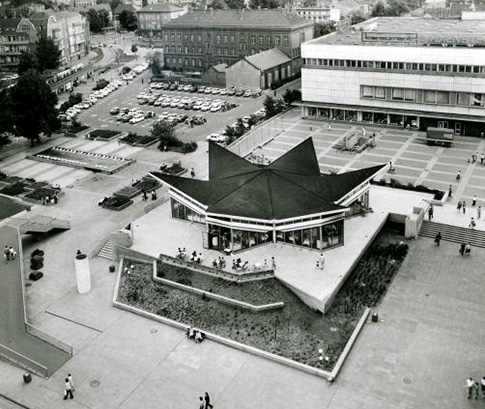The architectural heritage of high modernism
The evaluation and sustainable preservation of the structural heritage of high modernism are topics of the interdisciplinary Priority Programme 2255 "Cultural Heritage Construction" (SPP 2255) of the German Research Foundation (DFG).
The Cottbus city promenade was once an important ensemble of late high modernist GDR urban development. Its centrepiece was the mocha-milk ice cream bar "Kosmos", built in 1969, whose star-shaped curved shell roof merged architecture and engineering into a powerful unity. "Almost twenty years ago, the building was demolished because its value had not been recognised," regrets Prof. Dr Werner Lorenz, coordinator of the priority programme. "It shares this fate with numerous important buildings from the era of high modernism. Many are demolished or disfigured beyond recognition by modernisation. Every day, evidence of the architecture and building techniques of an entire era is irretrievably lost."
To prevent this, the BTU scientist and his team are coordinating the Germany-wide research network. This interdisciplinary network brings together around 100 researchers from the fields of History, Architectural Conservation and Civil Engineering to develop the necessary foundations for the preservation of endangered architectural monuments. They are working together on three subject areas:
- Research into characteristic building methods and construction types of the high modernist period
- Development of effective approaches, quality criteria and methods for the heritage assessment of ultra-modern buildings and their complex structures
- Development of networked action strategies for the preservation and further development of the ultra-modern cultural heritage
"It is often the innovative building materials, the supporting structure or the manufacturing process that determine the heritage value of these ultra-modern buildings: the construction becomes the actual cultural heritage," says Roland May, scientific curator of SPP 2255 at BTU Cottbus-Senftenberg. "However, strategies and methods for the evaluation and preservation of monuments have only been rudimentarily developed to date. There is a lack of decisive foundations in the history of building technology, monument theory and engineering science.
With the Priority Programme 2255 "Cultural Heritage Construction", the DFG is funding a research network coordinated from Cottbus, in which the competences of the disciplines are bundled across disciplines and locations. The aim is to develop a new type of engineering-based and networked Architectural Conservation that can do justice to the complex realities of ultra-modern heritage. In terms of content, the projects cover a wide range from engineering structures such as railway bridges or hall buildings to specific ultra-modern methods and building materials in serial prefabrication through to presentation and test models. The methodological spectrum ranges from historical-empirical approaches to material-related approaches for refurbishment and preservation to engineering studies on load-bearing behaviour and strengthening options.
The SPP 2255 extends over two funding phases. In addition to the Cottbus coordination project, it comprised eleven sub-projects in the first funding phase (2021-2023), whose interdisciplinary teams carried out 26 closely interlinked research projects. The second funding phase (2024-2026) comprises a total of 19 research projects.
Expert contact
Prof. Dr.-Ing. Werner Lorenz, Dr.-Ing. Roland May
SPP 2255 Cultural Heritage Construction
Teaching Building 2 C/D, Room 127
T +49 355 69 4640
E contact(at)kulturerbe-konstruktion.de

